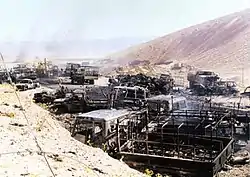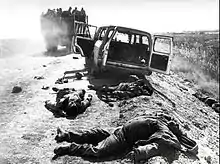Operation Mersad
Operation Mersad (Persian: عملیات مرصاد, lit. Operation Ambush, Iranian codename), alternatively referred to as Operation Forough Javidan (Persian: عملیات فروغ جاویدان, lit. Operation Eternal Light, MeK's codename), was the last major military operation of the Iran–Iraq War, conducted by and ending in a decisive victory for Iran. The operation involved a successful counterattack against a July 1988 military incursion from Iraq by a military force of about 7,000 militants from the Mujahedin-e-Khalq (MEK). The MEK militants were armed, equipped and given air support by the Iraqi military. Led by Lieutenant-General Ali Sayad Shirazi, Operation Mersad began on 26 July 1988 and lasted only a few days, whereby the Iranian Armed Forces crushed the MEK in what was the last military operation of any major significance during the war.
| Operation Mersad | |||||||||
|---|---|---|---|---|---|---|---|---|---|
| Part of the Iran–Iraq War | |||||||||
 Burned-out vehicles shown in the aftermath of Operation Mersad | |||||||||
| |||||||||
| Belligerents | |||||||||
| |||||||||
| Commanders and leaders | |||||||||
| Units involved | |||||||||
|
|
| ||||||||
| Strength | |||||||||
|
7,000 MEK troops 90,000 Iraqis engaged 900,000 total 300 tanks unknown number of artillery pieces and aircraft |
210,000 Iranians engaged 1,200,000 total 365 tanks unknown number of artillery pieces and aircraft | ||||||||
| Casualties and losses | |||||||||
|
1,500 to 2,506 KIA (Iranian claim)[2] 400 APCs 90 pieces of 80mm mortar 150 pieces of 60mm mortar 30 pieces of 106mm recoilless rifles |
400 KIA (Iranian claim) | ||||||||
Both Iran and Iraq had accepted United Nations Security Council Resolution 598, which would end the war on 8 August 1988. However, the Iraqi-backed Mujahedin-e-Khalq militant group seized the opportunity to attack central Iran before the ceasefire came into effect. The attack was decisively defeated by the Iranian military.[1]
Prelude
On 20 July 1987 the Iran–Iraq War was coming to an end under the United Nations Security Council Resolution 598.[7][8] Iran had suffered major defeats in southern Iraq during the Second Battle of Al Faw and Operation Tawakalna ala Allah as well as along the central portion of the border within Iran, and was contemplating on accepting[7] the ceasefire. On July 26 1988, six days after Ayatollah Khomeini had officially announced his acceptance of the UN brokered ceasefire resolution as well as seeing Iraqi victories in the previous months, the MEK advanced under heavy Iraqi air cover, crossing the Iranian border from Iraq.[1] It advanced to a maximum distance of 145 km(90 mi) and along the way seized and razed to the ground the Iranian town of Eslamabad-e Gharb. As it advanced further into Iran, Iraq ceased its air support and Iranian forces cut off NLA (National Liberation Army of Iran i.e.MEK forces) supply lines and counterattacked under cover of fighter planes and helicopter gunships.
The attack agreed upon by the Iraqi leadership would be a two pronged assault. One portion of the MEK force would attack Iranian forces in Iraqi Kurdistan, the area was still in Iranian and Peshmerga hands. When the Iranian troops moved to fight off the MEK attack in Kurdistan, the renegade Iranian militant group the Mujahedeen-e-Khalq (MEK), supported by Iraqi air power, would launch a large scale incursion into the central portion of Iran, aiming towards the heart of Iran. The MEK under their leader Massoud Rajavi harbored the hope that the attack would lead to a general uprising against the Islamic government of Ayatollah Khomeini. Rajavi would lead the Mujahedeen with Iraqi support in an attack on the western borders of Iran.[9]
Operation Forough Javidan (Eternal Light)
On 26 July 1988, the MEK, with the support of the Iraqi military, started Operation Forough Javidan (Eternal Light) in central Iran. The Mujahedeen worked with the Iraqi Air Force, advancing towards the Iranian city of Kermanshah and advanced rapidly, seizing and destroying the towns of Qasr-e Shirin, Sarpol-e Zahab, Kerend-e Gharb, and Islamabad-e Gharb.[1][10] The MEK met scant resistance from the limited numbers of Revolutionary Guards, which were promptly defeated, pushing 145 km (90 mi) deep into Iran towards the provincial capital city of Kermanshah and the road to Tehran seemed to be wide open.
Iran's Kurdish fighters did somewhat slow the advance, allowing time for the Iranians to prepare their counteroffensive. Once the MEK had advanced beyond the range of effective Iraqi air cover, giving the Iranians air superiority, the Iranian military launched its counter-attack, Operation Mersad, under Lieutenant General Ali Sayyad Shirazi. Iranian paratroopers landed behind the overstretched MEK lines. Iranian Air Force F-4 Phantoms bombed Mujahedeen convoys on the Kermanshah highway, followed by Army Aviation helicopters using anti-tank missiles. Most enemy armour was destroyed, in a miniature version of the Highway of Death during the Persian Gulf War. The MEK advance had been abruptly and completely halted. The Iranian army and Revolutionary Guard then moved north from Khuzestan, encircling and suppressing the remaining resistance in the city of Kerend-e Gharb on 29 July 1988.
On 31 July, Iran drove MEK forces out of Qasr-e-Shirin and Sarpol Zahab, though the MEK claimed to have "voluntarily withdrawn" from the towns. Iran estimated that 4,500 Mujahedeen soldiers were killed, while 400 Iranian soldiers died. The Iranian successes during Operation Mersad were partially due to their decision to establish a unified command structure and permanently quash the differences between the Army and the Revolutionary Guard.
Aftermath

Under pressure from other Arab states Saddam and MEK did not launch any more attacks on Iran. Operation Mersad was the last land battle of the Iran–Iraq War.
The last notable combat actions of the war took place on 3 August 1988, in the Persian Gulf when the Iranian navy fired on a freighter and Iraq launched chemical attacks on Iranian civilians, killing an unknown number of them and wounding 2,300.
Both sides eventually withdrew to the international border in the coming weeks, with Resolution 598 becoming effective on 8 August 1988, ending all combat operations between the two countries.[102] By 20 August 1988, peace with Iran was restored. UN peacekeepers belonging to the UNIIMOG mission took the field, remaining on the Iran–Iraq border until 1991. While the war was now over, Iraq spent the rest of August and early September clearing the Kurdish resistance. Using 60,000 troops along with helicopter gunships, chemical weapons (poison gas), and mass executions, Iraq hit 15 villages, killing rebels and civilians, and forced tens of thousands of Kurds to relocate to forced settlements.[99] Many Kurdish civilians immigrated to Iran. By 3 September 1988, the anti-Kurd campaign ended, and all resistance had been crushed.[99] 400 Iraqi soldiers and 50,000 Kurdish civilians and soldiers had been killed.
At least in part as a response to the invasion, Iran executed several thousand political prisoners across the country for treason, mainly members of the MEK, but also members of the Tudeh Party (Communist Party) and other opposition groups.[11] The estimates for number of executions vary from as little as 1,400[12] to as high as 12,000. The most likely number was given by dissident Ayatollah Hussein-Ali Montazeri, as being between 3,800–4,500.[13] The death toll may have been higher for those MEK executed by frontline court-martials or dying in prison.
Bibliography
- Farrokh, Kaveh (20 December 2011). Iran at War: 1500–1988. Osprey Publishing. p. 609. ISBN 978-1-78096-221-4.
- "The Lessons of Modern War - Volume II - The Iran–Iraq War (Chapter 10: The Combination Of Iraqi Offensives And Western Intervention Force Iran To Accept A Cease-Fire: September 1987 To March 1989) - May, 1990 - 9005lessonsiraniraqii-chap10.pdf" (PDF). Retrieved 10 October 2014.
References
- Farrokh, Kaveh. Iran at War: 1500–1988. Oxford: Osprey Publishing. ISBN 978-1-78096-221-4.
- Yaghoub Nemati Voroujeni (Summer 2012), "Mujahadeen-e-Khalq (MEK) Organization in the Imposed War", Negin-e-Iran (in Persian), 41 (11): 75–96, archived from the original on 18 November 2016, retrieved 2 December 2016
- بخشهایی از گزارش نهایی ستاد فرماندهی ارتش آزادیبخش ملی ایران درباره عملیات بزرگ فروغ جاویدان ـ ۸ شهریور ۱۳۶۷
- "The Cult of Rajavi" by Elizabeth Rubin. New York Times, 13 July 2003
- "Memories of a slaughter in Iran". iranfocus.com. Retrieved 10 October 2014.
- Lamb, Christina (19 June 2001). "Khomeini fatwa 'led to killing of 30,000 in Iran'". The Daily Telegraph. Archived from the original on 29 March 2008. Retrieved 10 October 2014.
- "Basis for an End to Persian Gulf Fighting: Security Council Resolution 598". nytimes.
- "Iraq-Islamic Republic of Iran". unscr.
- Hiro, Dilip, The Longest War, (1999), pp. 246–47
- "MOJAHEDIN KHALQ (MKO, MEK, RAJAVI CULT) FROM "FOROUGH" TO TODAY'S LIMBO". iran-interlink. Retrieved 28 July 2013.
- Iranian party demands end to repression Archived 2005-09-24 at the Wayback Machine
- Massacre 1988 (Pdf)
- "The Bloody Red Summer of 1988". FRONTLINE – Tehran Bureau. Retrieved 10 October 2014.
External links
 Media related to Operation Mersad at Wikimedia Commons
Media related to Operation Mersad at Wikimedia Commons- sajed.ir in English – The Official site of Holy Defence – Iraq-Iran War 1980–88